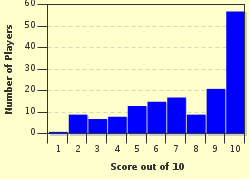Quiz Answer Key and Fun Facts
1. Giotto di Bondone completed a number of frescoes between 1300 and 1306 in Padua, in the Scrovegni Chapel. One of these frescoes shows us a kiss - one of the first artistic kiss of which we know the artist and the date. It shows us the parents of Virgin Mary meeting at the Golden Gate. What is the name of this kissing married couple?
2. Hieronymus Bosch made a number of large panels that are overpopulated with (mainly nude) figures, most of which are surrealistically deformed. One of his best known paintings shows us (among many other weird appearances) a nude man and a nude woman, enclosed in a soap bubble, when the man starts caressing the woman's belly and tries to kiss her on the mouth. What is the English name of this painting?
3. Most paintings of "Madonna and Child" show us the Virgin Mary staring at someone or something in the room where the visitors of the painting stroll, and Jesus Christ sitting (quite rigidly) on her lap. One of the few exceptions is the painting a minor Flemish artist made between 1500 and 1510. In this particular painting, Mary kisses Jesus on the mouth. To see this "Madonna with Child", you'll have to pay a visit to the Gemäldegalerie in Berlin. Who produced this extraordinary painting?
4. Benvenuto Cellini made between 1528 and 1530 a famous artwork entitled "Leda and the Swan". In this masterpiece, you'll see a nude woman kissing a swan (which really is Jupiter, or Zeus if you prefer Greek mythology, in disguise). Which object was decorated with this "Leda and the Swan"?
5. The statue "Amor and Psyche" (1793), which you can admire in the Louvre in Paris, was made by an Italian Classical sculptor. In this statue, you'll find a reclining woman (with only a drape covering her waist) reaching out for a nude young man, wearing only a pair of wings on his back. (What would modern fashion designers say about such a spectacle...) Who made this sculpture?
6. The kiss is a theme that has influenced many artists of all over the world. Japanese painters such as Katsushige Hokusai and Kitagawa Utamaro made paintings or xylographic images of kissing couples. What is the Japanese term for the art movement including Hokusai and Utamaro?
7. In 1881, Pierre Auguste Renoir painted "Luncheon of the Boating Party" ("Le déjeuner des canotiers"). In this painting, you'll find many of Renoir's friends and acquaintances. The girl on the front left seems to attract all attention, because of the somewhat peculiar activity she's involved in. What is she doing?
8. The most famous sculpture representing a kiss was made by Auguste Rodin and bears the title "The Kiss". It represents a nude male on whose lap a nude female crawls to kiss him. These persons would refer to a dramatic Italian love affair. Who are the adulterous lovers depicted in this sculpture? By the way, Dante finds these people in hell.
9. One of the best-known paintings bearing the title "The Kiss" was made by an Austrian painter in 1908. Who was this Austrian painter? The kissing couple is depicted against a golden background.
10. The painting I will discuss in this question is entitled "Birthday" and was made in 1915. It shows us a young woman searching for a vase to put some flowers in, and her lover trying to kiss her. The reason why this painting made a lasting impression on my memory is the weird position of the kissing lover. It seems he hovers some two feet above the floor, his feet pointing away from the woman in the picture. And yet, he succeeds in turning his face towards her, in order to kiss her on the mouth.
Smart quizzers as you are, you have already guessed that I'll ask you for the name of the painter. He was made a French citizen in 1937, and he hails from Russian Jews. Who was this artist?
Source: Author
JanIQ
This quiz was reviewed by FunTrivia editor
CellarDoor before going online.
Any errors found in FunTrivia content are routinely corrected through our feedback system.

